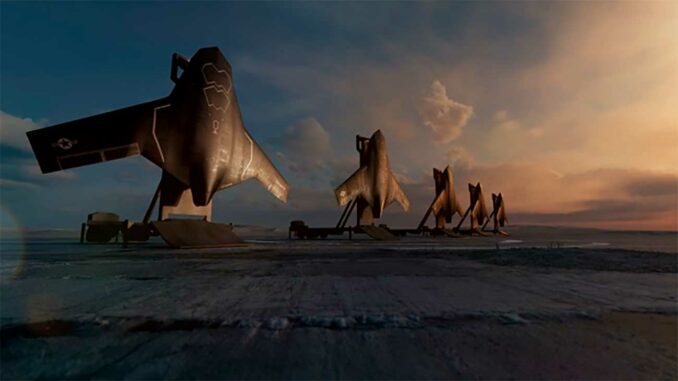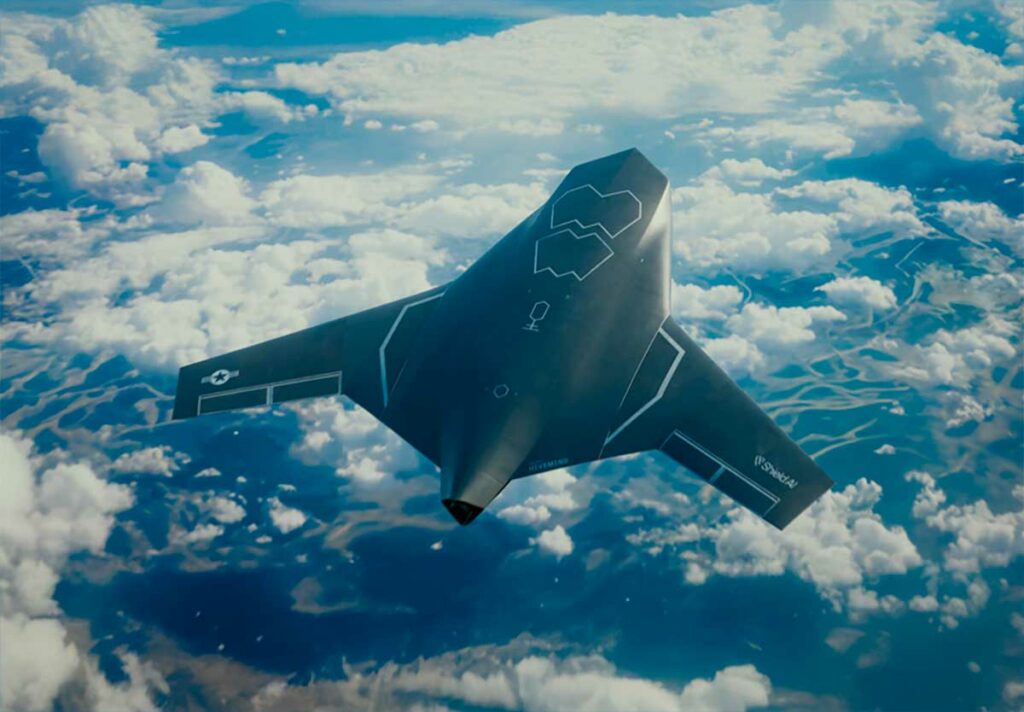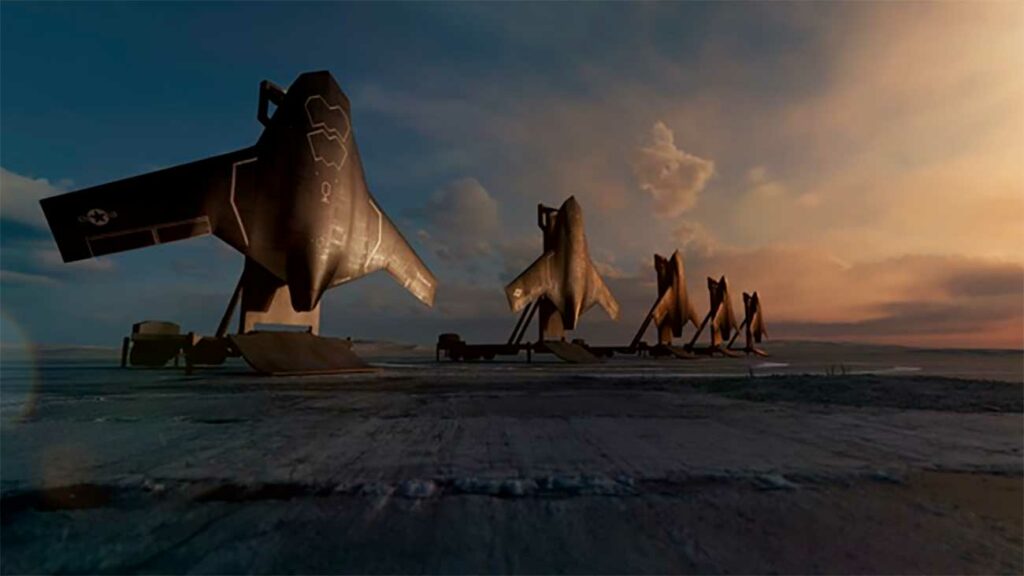
Shield AI presents the X-BAT, an autonomous VTOL fighter jet piloted by Hivemind: range, cost, testing schedule and operational challenges analysed.
Understand in 2 minutes
Shield AI, valued at $5.3 billion, unveils X-BAT, an unmanned combat aircraft equipped with VTOL (vertical take-off and landing) and piloted by Hivemind AI. Designed for strike, EW, and ISR missions, it claims a range of nearly 2,000 miles, an operational altitude of up to 50,000 feet, and a target unit cost of around $27 million (~€23.3 million). The programme is banking on low-cost manufacturing and integration with wingman drone concepts, but it still needs to prove itself in terms of safety, robustness in contested environments and acceptance by the armed forces.
The X-BAT and the Hivemind platform
Shield AI presents the X-BAT as a fighter without a human pilot on board, designed to operate vertically from limited surfaces (ships, improvised areas) and to carry out strike, counter-air, electronic warfare and ISR missions. The company places its autonomous Hivemind software at the heart of the system, presenting it as the software component that enables the drone to make tactical decisions in the absence of a link or GPS reference point. According to press releases and media coverage of the announcement, the claimed characteristics are a range of approximately 2,000 miles, an operational ceiling of around 50,000 feet, and the ability to take off and land vertically, which opens up scenarios for use from ship hulls or mobile platforms.
Technically, the combination of a compact turbojet engine and a VTOL lift system involves clear trade-offs: payload, intake architecture, cooling, and avionics integration. The main challenge is to ensure a safe transition between hover mode and high-speed cruise flight. Previous demonstrations by Shield AI — notably the integration of Hivemind on an X-62A VISTA during a close combat exercise — show that the algorithm can handle highly dynamic manoeuvres, but not yet the full production of an autonomous VTOL fighter in a multi-source operational environment. The X-BAT’s design will also need to incorporate passive radar stealth, resistance to electronic countermeasures, and a modular architecture for payloads (sensors, weapons, EW pods).

The market, costs and competition
Shield AI has indicated that it intends to produce the X-BAT at a target unit cost of approximately $27 million (≈ €23.3 million based on the EUR/USD exchange rate on 22 October 2025, ~0.8615). This positioning aims to place the X-BAT as a significantly less expensive alternative to conventional fighters — the order of magnitude mentioned for 5th generation aircraft such as the ** F-35** regularly exceeds $100 million per unit according to recent batches — and thus to enable large-scale deployment and an ‘augmented force’ strategy using swarms of drones.
On an industrial and commercial level, Shield AI currently operates in a competitive ecosystem dominated by established players (Lockheed Martin, Northrop Grumman) and ‘prime startups’ such as Anduril. The £240 million raised and the announced valuation of £5.3 billion constitute financial validation that facilitates access to supply chains and test contracts, but the transition from prototype to series production raises additional investment needs for the production line, military qualification and logistical support. In addition, Shield AI has secured operational contracts (e.g., for the V-BAT fleet with the U.S. Coast Guard) that attest to a growing level of operational confidence—these commercial successes are assets in convincing buyers and partner states.
Competition surrounding the Collaborative Combat Aircraft (CCA) programmes and the Defence’s requests for ‘loyal wingmen’ pits several concepts against each other and will require Shield AI to demonstrate not only individual performance, but also swarm integration, predictable maintenance and a competitive total cost of ownership. The promise of low unit cost is not enough: availability, hourly flight cost, spare parts and on-board logistics must be quantified in order for the programme-by-programme evaluation to be favourable.
The challenge of safety and operational acceptance
Autonomy in lethal domains imposes a triple requirement: technical reliability, compliance with rules of engagement, and ethical acceptance by decision-makers. Shield AI has already achieved operational results (V-BAT), but the company has also experienced events that have impacted customer confidence. An incident reported during a demonstration in 2023, in which a member of the armed forces was injured during a drone recovery, raised questions about safety procedures and the robustness of the systems in unforeseen conditions. The company presents its management of this crisis and the upgrading of safety procedures as lessons learned that will be applied to future developments.
On a technical level, the certification of an autonomous combat system requires repeated testing in degraded scenarios: electronic jamming, communication losses, extreme weather conditions, and human interference in recovery areas. It will be necessary to prove that algorithms such as Hivemind achieve safety levels comparable to those required for manned systems; This involves test benches, instrumented flights and the implementation of kill switches and layers of human supervision where necessary. Operational acceptance will also depend on the ability to guarantee the traceability of decisions (logs, black boxes) and to demonstrate that the final decision authority on strikes remains compliant with the legal and political frameworks of the user states. Ethical and legal issues will therefore remain at the heart of the technical and commercial roadmap.

Strategic and political implications
The arrival of an autonomous, low-cost, VTOL fighter jet is reshaping tactical options: distributed deterrence, operations from merchant hulls or light platforms, and reduced human risk on highly exposed missions. At the macro-political level, the US administration recently published measures to accelerate national dominance in the field of drones and AI for defence (Executive Order Unleashing American Drone Dominance), creating a favourable political environment for innovative American companies. These measures aim to promote domestic production, facilitate testing, and direct funds towards the integration of UAS and AI into the military arsenal.
However, the democratisation of autonomous combat aircraft poses risks of proliferation, escalation and misidentification. Partner militaries will need to define strict doctrines of use, limits on mission autonomy and rules of interoperability to ensure that these platforms truly increase operational capability without multiplying strategic risks. In addition, industrial competition will weigh on the supply chain and the balance between industrial sovereignty and foreign partnerships: selling X-BATs or Hivemind capabilities requires political decisions on technology transfers, co-productions and export controls.
War Wings Daily is an independant magazine.